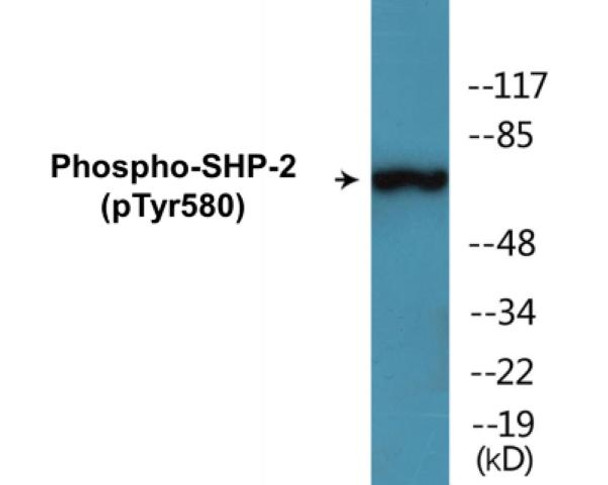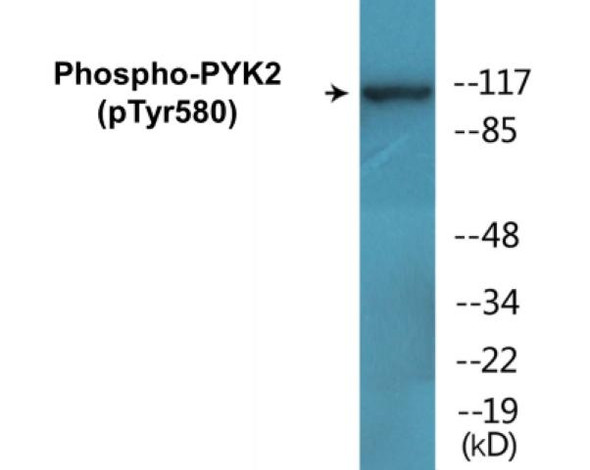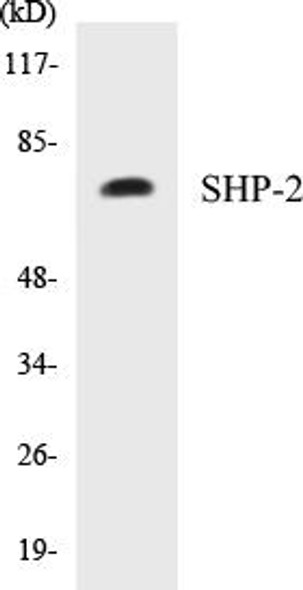SHP-2 (Phospho-Tyr580) Colorimetric Cell-Based ELISA Kit (CBCAB00055)
- SKU:
- CBCAB00055
- Product Type:
- ELISA Kit
- ELISA Type:
- Cell Based Phospho Specific
- Reactivity:
- Human
- Mouse
- Rat
- Detection Method:
- Colorimetric
Description
SHP-2 (Phospho-Tyr580)Colorimetric Cell-Based ELISA Kit
The SHP-2 Phospho-Tyr580 Colorimetric Cell-Based ELISA Kit is a cutting-edge tool designed for the accurate detection of SHP-2 phosphorylation at tyrosine 580 in cell samples. This kit offers high sensitivity and specificity, providing researchers with reliable and reproducible results for a variety of experimental settings.SHP-2 is a critical phosphatase enzyme that plays a key role in regulating various cellular processes, including cell growth, differentiation, and survival.
Phosphorylation of SHP-2 at tyrosine 580 is known to modulate its activity and function, impacting signaling pathways involved in cancer, metabolic disorders, and immune responses. As such, the SHP-2 Phospho-Tyr580 Colorimetric Cell-Based ELISA Kit is an essential tool for studying the role of SHP-2 in disease mechanisms and potential therapeutic interventions.
| Product Name: | SHP-2 (Phospho-Tyr580) Colorimetric Cell-Based ELISA |
| Product Code: | CBCAB00055 |
| ELISA Type: | Cell-Based |
| Target: | SHP-2 (Phospho-Tyr580) |
| Reactivity: | Human, Mouse, Rat |
| Dynamic Range: | > 5000 Cells |
| Detection Method: | Colorimetric 450 nm |
| Format: | 2 x 96-Well Microplates |
The SHP-2 (Phospho-Tyr580) Colorimetric Cell-Based ELISA Kit is a convenient, lysate-free, high throughput and sensitive assay kit that can detect SHP-2 protein phosphorylation and expression profile in cells. The kit can be used for measuring the relative amounts of phosphorylated SHP-2 in cultured cells as well as screening for the effects that various treatments, inhibitors (ie. siRNA or chemicals), or activators have on SHP-2 phosphorylation.
Qualitative determination of SHP-2 (Phospho-Tyr580) concentration is achieved by an indirect ELISA format. In essence, SHP-2 (Phospho-Tyr580) is captured by SHP-2 (Phospho-Tyr580)-specific primary antibodies while the HRP-conjugated secondary antibodies bind the Fc region of the primary antibody. Through this binding, the HRP enzyme conjugated to the secondary antibody can catalyze a colorimetric reaction upon substrate addition. Due to the qualitative nature of the Cell-Based ELISA, multiple normalization methods are needed:
| 1. | A monoclonal antibody specific for human GAPDH is included to serve as an internal positive control in normalizing the target absorbance values. |
| 2. | Following the colorimetric measurement of HRP activity via substrate addition, the Crystal Violet whole-cell staining method may be used to determine cell density. After staining, the results can be analysed by normalizing the absorbance values to cell amounts, by which the plating difference can be adjusted. |
| Database Information: | Gene ID: 5781, UniProt ID: Q06124, OMIM: 151100/163950/163955/176876/607785, Unigene: Hs.506852/Hs.646231 |
| Gene Symbol: | PTPN11 |
| Sub Type: | Phospho |
| UniProt Protein Function: | SHP-2: a SH2-containing a ubiquitously expressed tyrosine-specific protein phosphatase. It participates in signaling events downstream of receptors for growth factors, cytokines, hormones, antigens and extracellular matrices in the control of cell growth, differentiation, migration, and death. Activation of SHP-2 and its association with Gab1 is critical for sustained Erk activation downstream of several growth factor receptors and cytokines. |
| UniProt Protein Details: | Protein type:Motility/polarity/chemotaxis; Protein phosphatase, tyrosine (non-receptor); EC 3.1.3.48 Chromosomal Location of Human Ortholog: 12q24 Cellular Component: cytoplasm; cytosol; nucleus Molecular Function:1-phosphatidylinositol-3-kinase activity; insulin receptor binding; non-membrane spanning protein tyrosine phosphatase activity; phosphatidylinositol-4,5-bisphosphate 3-kinase activity; phosphoprotein phosphatase activity; protein binding; protein tyrosine phosphatase activity; SH3/SH2 adaptor activity Biological Process: brain development; ephrin receptor signaling pathway; epidermal growth factor receptor signaling pathway; fibroblast growth factor receptor signaling pathway; genitalia development; heart development; inner ear development; leukocyte migration; phosphoinositide-mediated signaling; platelet activation; regulation of cell adhesion mediated by integrin; regulation of phosphoinositide 3-kinase cascade; regulation of protein complex assembly; T cell costimulation Disease: Juvenile Myelomonocytic Leukemia; Leopard Syndrome 1; Metachondromatosis; Noonan Syndrome 1 |
| NCBI Summary: | The protein encoded by this gene is a member of the protein tyrosine phosphatase (PTP) family. PTPs are known to be signaling molecules that regulate a variety of cellular processes including cell growth, differentiation, mitotic cycle, and oncogenic transformation. This PTP contains two tandem Src homology-2 domains, which function as phospho-tyrosine binding domains and mediate the interaction of this PTP with its substrates. This PTP is widely expressed in most tissues and plays a regulatory role in various cell signaling events that are important for a diversity of cell functions, such as mitogenic activation, metabolic control, transcription regulation, and cell migration. Mutations in this gene are a cause of Noonan syndrome as well as acute myeloid leukemia. Two transcript variants encoding different isoforms have been found for this gene. [provided by RefSeq, May 2012] |
| UniProt Code: | Q06124 |
| NCBI GenInfo Identifier: | 84028248 |
| NCBI Gene ID: | 5781 |
| NCBI Accession: | Q06124.2 |
| UniProt Secondary Accession: | Q06124,Q96HD7, A8K1D9, |
| UniProt Related Accession: | Q06124 |
| Molecular Weight: | 52,828 Da |
| NCBI Full Name: | Tyrosine-protein phosphatase non-receptor type 11 |
| NCBI Synonym Full Names: | protein tyrosine phosphatase, non-receptor type 11 |
| NCBI Official Symbol: | PTPN11 |
| NCBI Official Synonym Symbols: | CFC; NS1; JMML; SHP2; BPTP3; PTP2C; METCDS; PTP-1D; SH-PTP2; SH-PTP3 |
| NCBI Protein Information: | tyrosine-protein phosphatase non-receptor type 11 |
| UniProt Protein Name: | Tyrosine-protein phosphatase non-receptor type 11 |
| UniProt Synonym Protein Names: | Protein-tyrosine phosphatase 1D; PTP-1D; Protein-tyrosine phosphatase 2C; PTP-2C; SH-PTP2; SHP-2; Shp2; SH-PTP3 |
| Protein Family: | Tyrosine-protein phosphatase non-receptor |
| UniProt Gene Name: | PTPN11 |
| UniProt Entry Name: | PTN11_HUMAN |
| Component | Quantity |
| 96-Well Cell Culture Clear-Bottom Microplate | 2 plates |
| 10X TBS | 24 mL |
| Quenching Buffer | 24 mL |
| Blocking Buffer | 50 mL |
| 15X Wash Buffer | 50 mL |
| Primary Antibody Diluent | 12 mL |
| 100x Anti-Phospho Target Antibody | 60 µL |
| 100x Anti-Target Antibody | 60 µL |
| Anti-GAPDH Antibody | 60 µL |
| HRP-Conjugated Anti-Rabbit IgG Antibody | 12 mL |
| HRP-Conjugated Anti-Mouse IgG Antibody | 12 mL |
| SDS Solution | 12 mL |
| Stop Solution | 24 mL |
| Ready-to-Use Substrate | 12 mL |
| Crystal Violet Solution | 12 mL |
| Adhesive Plate Seals | 2 seals |
The following materials and/or equipment are NOT provided in this kit but are necessary to successfully conduct the experiment:
- Microplate reader able to measure absorbance at 450 nm and/or 595 nm for Crystal Violet Cell Staining (Optional)
- Micropipettes with capability of measuring volumes ranging from 1 µL to 1 ml
- 37% formaldehyde (Sigma Cat# F-8775) or formaldehyde from other sources
- Squirt bottle, manifold dispenser, multichannel pipette reservoir or automated microplate washer
- Graph paper or computer software capable of generating or displaying logarithmic functions
- Absorbent papers or vacuum aspirator
- Test tubes or microfuge tubes capable of storing ≥1 ml
- Poly-L-Lysine (Sigma Cat# P4832 for suspension cells)
- Orbital shaker (optional)
- Deionized or sterile water
*Note: Protocols are specific to each batch/lot. For the correct instructions please follow the protocol included in your kit.
| Step | Procedure |
| 1. | Seed 200 µL of 20,000 adherent cells in culture medium in each well of a 96-well plate. The plates included in the kit are sterile and treated for cell culture. For suspension cells and loosely attached cells, coat the plates with 100 µL of 10 µg/ml Poly-L-Lysine (not included) to each well of a 96-well plate for 30 minutes at 37°C prior to adding cells. |
| 2. | Incubate the cells for overnight at 37°C, 5% CO2. |
| 3. | Treat the cells as desired. |
| 4. | Remove the cell culture medium and rinse with 200 µL of 1x TBS, twice. |
| 5. | Fix the cells by incubating with 100 µL of Fixing Solution for 20 minutes at room temperature. The 4% formaldehyde is used for adherent cells and 8% formaldehyde is used for suspension cells and loosely attached cells. |
| 6. | Remove the Fixing Solution and wash the plate 3 times with 200 µL 1x Wash Buffer for five minutes each time with gentle shaking on the orbital shaker. The plate can be stored at 4°C for a week. |
| 7. | Add 100 µL of Quenching Buffer and incubate for 20 minutes at room temperature. |
| 8. | Wash the plate 3 times with 1x Wash Buffer for 5 minutes each time. |
| 9. | Add 200 µL of Blocking Buffer and incubate for 1 hour at room temperature. |
| 10. | Wash 3 times with 200 µL of 1x Wash Buffer for 5 minutes each time. |
| 11. | Add 50 µL of 1x primary antibodies Anti-SHP-2 (Phospho-Tyr580) Antibody, Anti-SHP-2 Antibody and/or Anti-GAPDH Antibody) to the corresponding wells, cover with Parafilm and incubate for 16 hours (overnight) at 4°C. If the target expression is known to be high, incubate for 2 hours at room temperature. |
| 12. | Wash 3 times with 200 µL of 1x Wash Buffer for 5 minutes each time. |
| 13. | Add 50 µL of 1x secondary antibodies (HRP-Conjugated AntiRabbit IgG Antibody or HRP-Conjugated Anti-Mouse IgG Antibody) to corresponding wells and incubate for 1.5 hours at room temperature. |
| 14. | Wash 3 times with 200 µL of 1x Wash Buffer for 5 minutes each time. |
| 15. | Add 50 µL of Ready-to-Use Substrate to each well and incubate for 30 minutes at room temperature in the dark. |
| 16. | Add 50 µL of Stop Solution to each well and read OD at 450 nm immediately using the microplate reader. |
(Additional Crystal Violet staining may be performed if desired – details of this may be found in the kit technical manual.)






